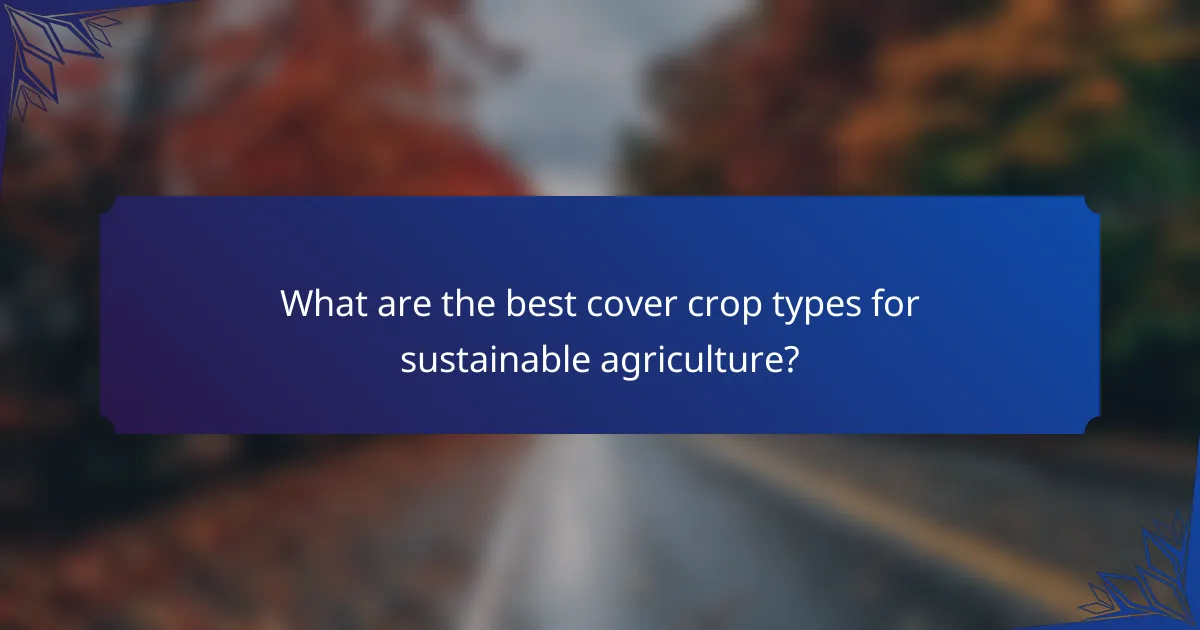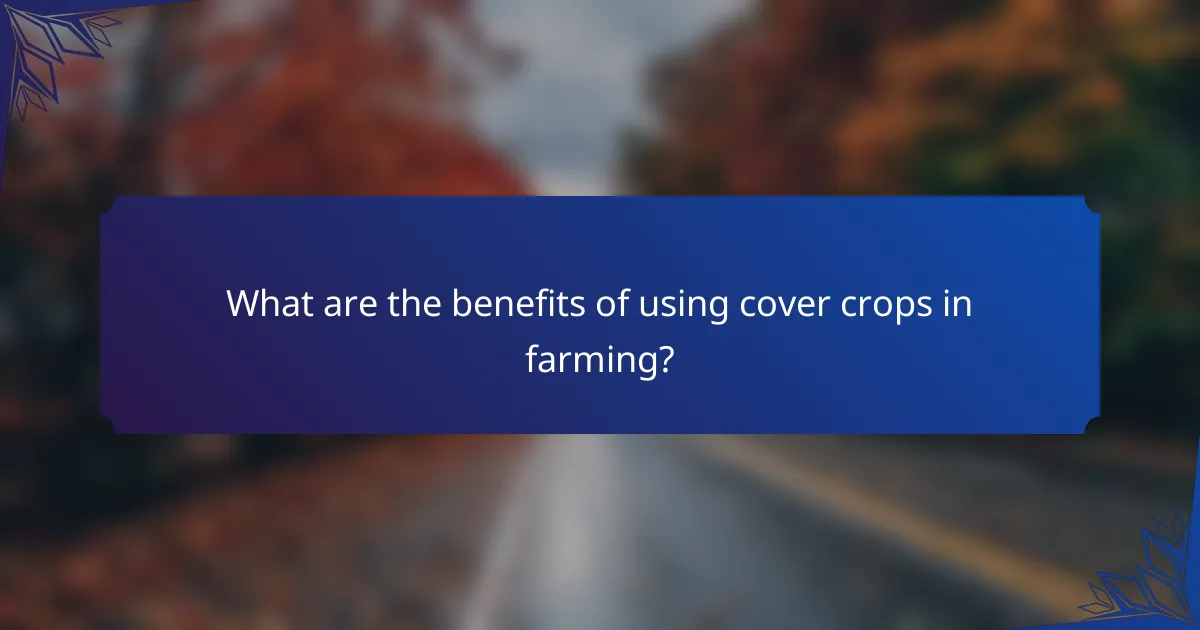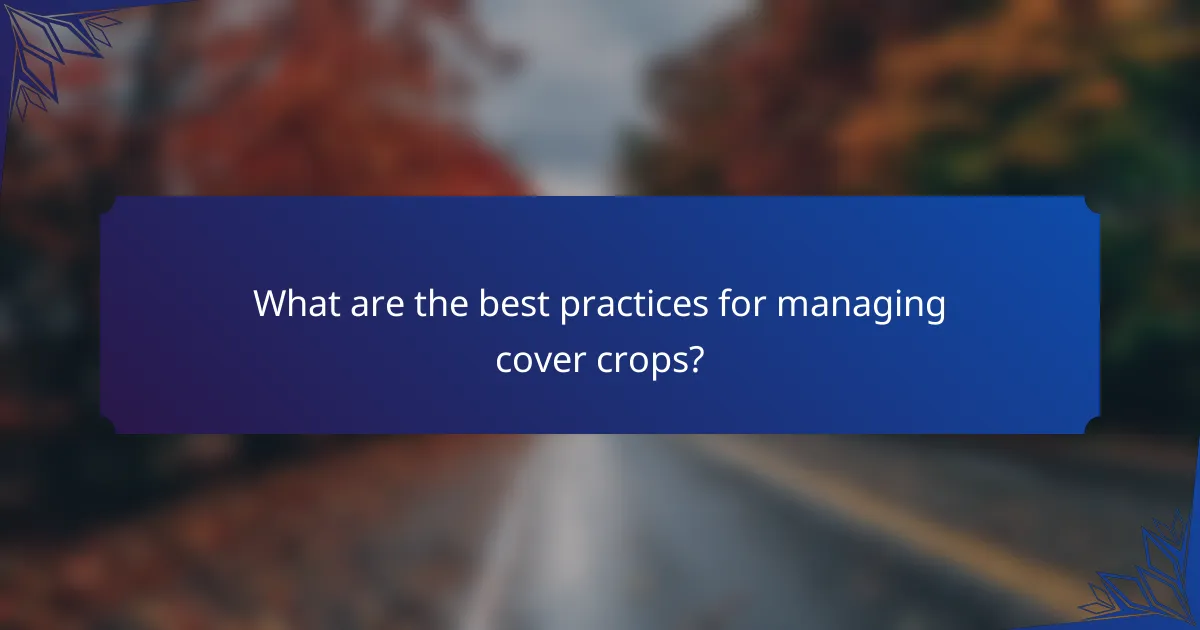Cover crops are an essential tool in sustainable agriculture, offering a variety of types such as legumes, brassicas, and grasses, each with distinct benefits like nitrogen fixation and soil health improvement. By strategically planting these crops during off-seasons, farmers can enhance soil fertility, moisture retention, and biodiversity, ultimately leading to more productive and resilient farming systems.

What are the best cover crop types for sustainable agriculture?
The best cover crop types for sustainable agriculture include legumes, brassicas, grasses, and mixed species. Each type offers unique benefits such as nitrogen fixation, soil health improvement, erosion control, and enhanced biodiversity.
Legumes for nitrogen fixation
Legumes, such as clover and vetch, are excellent for nitrogen fixation, which enriches soil fertility. They have a symbiotic relationship with nitrogen-fixing bacteria, converting atmospheric nitrogen into a form that plants can use.
When planting legumes, consider incorporating them into your crop rotation. This practice can reduce the need for synthetic fertilizers, potentially saving costs and improving soil health.
Brassicas for soil health
Brassicas, including radishes and mustards, contribute to soil health by breaking up compacted layers and improving soil structure. Their deep roots can reach nutrients that are otherwise inaccessible to other plants.
Planting brassicas in the fall can help suppress weeds and pests, making them a strategic choice for winter cover crops. They can also enhance organic matter when tilled back into the soil in spring.
Grasses for erosion control
Grasses like rye and barley are effective for erosion control due to their extensive root systems that stabilize the soil. They help prevent soil loss during heavy rains and improve water infiltration.
When using grasses as cover crops, aim to plant them early in the fall to maximize growth before winter. This practice not only protects the soil but also provides biomass that can be beneficial for subsequent crops.
Mixed species for biodiversity
Using mixed species cover crops can enhance biodiversity, leading to improved soil health and pest management. A combination of legumes, brassicas, and grasses can provide a range of benefits, including nutrient cycling and disease suppression.
Consider planting a diverse mix tailored to your specific soil and climate conditions. This approach can create a more resilient ecosystem, reducing reliance on chemical inputs and fostering a healthier agricultural environment.

What are the benefits of using cover crops in farming?
Cover crops provide numerous advantages for farming, including improved soil health, moisture retention, and natural pest control. By planting these crops during off-seasons, farmers can enhance their land’s productivity and sustainability.
Improved soil fertility
Cover crops contribute to enhanced soil fertility by fixing nitrogen and adding organic matter. Leguminous plants, such as clover and vetch, are particularly effective at enriching the soil with nitrogen, which is essential for crop growth.
Incorporating cover crops into the rotation can increase soil organic matter by several percent over time, leading to better nutrient availability and soil structure. This practice not only benefits current crops but also sets the stage for future planting seasons.
Enhanced moisture retention
Cover crops play a crucial role in improving moisture retention in the soil. Their root systems create channels that allow water to penetrate deeper, reducing runoff and evaporation.
By maintaining soil cover, these crops help to minimize moisture loss during dry periods, which is particularly beneficial in regions with variable rainfall. Farmers can expect better drought resilience and reduced irrigation costs as a result.
Weed suppression
Using cover crops can significantly suppress weed growth by outcompeting them for resources. Dense plantings of cover crops shade the soil, limiting sunlight that weeds need to germinate and thrive.
Farmers should select cover crops that grow quickly and establish a robust canopy, such as rye or buckwheat, to maximize weed suppression. This strategy can reduce the need for herbicides, leading to lower input costs and a more environmentally friendly approach.
Pest management
Cover crops can aid in natural pest management by attracting beneficial insects and disrupting pest life cycles. Certain cover crops can serve as trap crops, diverting pests away from main crops.
Incorporating diverse cover crops can enhance biodiversity on the farm, which helps to establish a balanced ecosystem. This reduces reliance on chemical pesticides and promotes healthier crop production.

How do you effectively plant cover crops?
Effectively planting cover crops involves selecting the right species, timing the planting correctly, and preparing the soil adequately. These steps ensure optimal growth and maximize the benefits of cover crops for soil health and fertility.
Timing for optimal growth
Timing is crucial for the successful establishment of cover crops. Generally, cover crops should be planted after the main cash crop is harvested but before the onset of winter. This allows them to establish roots and grow during the fall months, which can enhance soil structure and nutrient availability.
In warmer climates, consider planting cover crops in late summer or early fall to take advantage of the growing season. In cooler regions, aim for planting at least 4-6 weeks before the first frost to ensure adequate growth.
Soil preparation techniques
Preparing the soil properly before planting cover crops can significantly impact their success. Start by testing the soil to determine its nutrient levels and pH, which can guide your choice of cover crop species. Tilling the soil lightly can help incorporate organic matter and improve seed-to-soil contact.
Additionally, consider using a no-till approach to minimize soil disturbance, which can preserve soil structure and microbial life. If using tillage, avoid deep tilling, as it can disrupt soil layers and lead to erosion.
Seed selection and rates
Selecting the right seeds is essential for achieving the desired benefits from cover crops. Choose species that are well-suited to your climate and soil type; common options include clover, rye, and vetch. Each species offers different advantages, such as nitrogen fixation or weed suppression.
When it comes to seeding rates, a general guideline is to use 60-120 pounds of seed per acre, depending on the species and desired density. Always refer to specific recommendations for the chosen cover crop to optimize growth and effectiveness.

What are the best practices for managing cover crops?
Effective management of cover crops involves careful planning and execution of termination, incorporation, and crop rotation strategies. These practices enhance soil health, improve nutrient cycling, and reduce erosion, ultimately leading to better crop yields.
Termination methods
Termination of cover crops can be achieved through various methods, including mechanical, chemical, and biological approaches. Mechanical termination involves mowing or tilling, while chemical methods use herbicides to kill the cover crop. Biological termination relies on natural processes, such as grazing by livestock.
Timing is crucial for effective termination; cover crops should be terminated before they set seed to prevent unwanted growth. Generally, termination should occur 1-2 weeks before planting the main crop to allow for proper decomposition and nutrient release.
Incorporation techniques
Incorporating cover crops into the soil can be done through tillage or no-till methods. Tillage involves turning the soil to mix in the cover crop residues, which can enhance soil structure and nutrient availability. No-till methods, on the other hand, leave the soil undisturbed, promoting soil health and reducing erosion.
When incorporating cover crops, aim for a depth of 6-8 inches to ensure effective mixing. It’s beneficial to monitor soil moisture levels, as overly wet conditions can hinder incorporation and lead to compaction.
Crop rotation strategies
Implementing crop rotation with cover crops can significantly improve soil fertility and pest management. By alternating cover crops with cash crops, farmers can break pest cycles and enhance nutrient diversity in the soil. For example, rotating legumes with grains can boost nitrogen levels in the soil.
Consideration of local climate and soil conditions is essential when planning crop rotations. A typical rotation might involve planting a cover crop in the fall, followed by a nitrogen-fixing crop in the spring, and then a cash crop in the summer. This strategy not only improves soil health but also maximizes productivity throughout the growing season.

What are the economic impacts of cover crops in the Midwest?
Cover crops significantly impact the economy in the Midwest by reducing input costs and enhancing agricultural productivity. Farmers can experience lower expenses on fertilizers, improved yields, and better long-term soil health, ultimately leading to more sustainable farming practices.
Cost savings on fertilizers
Using cover crops can lead to substantial savings on fertilizers. By improving soil fertility naturally, these crops reduce the need for synthetic fertilizers, which can be costly. Farmers may see reductions in fertilizer expenses by 20-50%, depending on the cover crop species and local soil conditions.
For example, legumes like clover and vetch fix nitrogen in the soil, decreasing the need for nitrogen fertilizers. This not only cuts costs but also minimizes environmental impacts associated with fertilizer runoff.
Increased crop yields
Cover crops can enhance crop yields by improving soil structure and moisture retention. Healthier soils lead to better root development and nutrient availability, often resulting in yield increases of 5-20% in subsequent cash crops.
Farmers in the Midwest have reported that incorporating cover crops before planting corn or soybeans can lead to more robust harvests. This increase in yield can offset the initial costs of planting cover crops, making it a financially sound practice.
Long-term soil health investments
Investing in cover crops contributes to long-term soil health, which is crucial for sustainable agriculture. Healthier soils improve water infiltration, reduce erosion, and enhance biodiversity, all of which can lead to more resilient farming systems.
Over time, the benefits of improved soil health can translate into lower costs for soil amendments and increased productivity. Farmers should view cover crops as a long-term investment rather than a short-term expense, as the cumulative benefits can significantly enhance farm profitability over the years.
